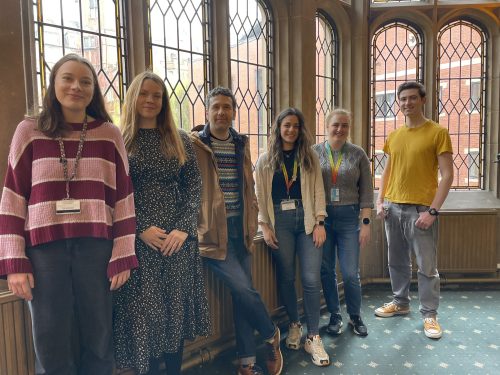Lab meeting with the Tsakiridis Lab
Posted by the Node, on 4 April 2024

Where is the lab?
The lab is in the School of Biosciences, University of Sheffield, UK.
Research summary
We aim to understand how human developmental cell fate decisions are controlled and exploit this knowledge for regenerative medicine and disease modelling applications. We are focusing particularly on defining how embryonic cells acquire an anteroposterior (A-P) axial identity and its effect on disease vulnerability and developmental potency/plasticity. To address our questions, we employ human pluripotent stem cell (hPSCs) differentiation as an in vitro model of early human embryonic development and utilise protocols we have recently established toward the production of human spinal cord progenitors and neural crest cells that correspond to distinct axial levels.
Current projects in our lab include:
1) Understanding how various cellular components of the trunk (e.g. motor neurons, paraxial mesoderm, trunk neural crest) are derived from multipotent axial progenitors.
2) Defining the molecular/signalling basis of A-P axial identity acquisition/maintenance in distinct neural cell types.
3) Deciphering the molecular/signalling logic of cell fate decisions in vagal neural crest derivatives focusing on the enteric nervous system and the treatment of enteric neuropathies such as Hirschsprung disease.
4) Determining how abnormal trunk neural crest development is linked to the initiation of neuroblastoma, the most common extra-cranial solid tumour of childhood.
Lab roll call
James Birch: PhD student, studying the links between cell competition and neuroblastoma initiation.
Katy Boswell: PhD student, investigating the effect of chromosome 17q gain/MYCN overactivation on the enhancer landscape of hPSC-derived trunk neural crest cells.
Fay Cooper: Postdoc, studying determinants of axial identity in spinal cord progenitors and neural crest cells. She has also been involved in the development of a hPSC-based cell therapy for treating Hirschsprung disease. More recently, Fay has been examining the effect of DNA damage on trunk neural crest differentiation in hPSCs harbouring various neuroblastoma-associated aberrations.
Grace Gilbert: Joint PhD student (primary supervisor: Dr Dan Bose), dissecting the effect of Rubinstein Taybi Syndrome disease mutations on the epigenetics of neural crest/neuronal development.
Sude Uyulgan: PhD student, working on the study of axial identity acquisition by hPSC-derived lateral plate mesoderm and limb progenitors.
Favourite technique, and why?
Anestis: Immunostaining/fluorescence microscopy analysis of neuronal projections simply because it usually produces images of immense hypnotic beauty.
Apart from your own research, what are you most excited about in developmental and stem cell biology?
Anestis: I am very excited about the increasing number of complementary 2 -and 3-D hPSC differentiation models, which together with emerging cutting-edge technologies in microscopy, sequencing and bioengineering offer for the first-time unique opportunities for controlling and understanding human developmental processes. They can also facilitate examining older classic embryology experiments/ concepts under a new lens. I am very keen on using these approaches in the near future to address specifically our group’s questions.
What is the best thing about where you work?
Anestis: The University of Sheffield hosts a vibrant developmental/stem cell biology community, and I have met some fantastic colleagues, collaborators and friends here.
Sude: Supportive and friendly atmosphere, exciting research, and most importantly having Anestis as a supervisor!
James: The University of Sheffield is a great place to work. We have regular fascinating seminars and the university has many support groups from research on aging to data analysis (Sheffield R Users Group) to support you on your research journey. The university really cares what we think, I’ve seen management respond to student and staff surveys and to really be willing to put funding behind making changes where needed. I think all these contribute to making Sheffield an exciting and supportive working environment.
Fay: The people…. we have a really great dynamic in the lab at the moment which makes it a really enjoyable place to work.
What’s there to do outside of the lab?
Anestis: Sheffield is home to lots of pubs/breweries (it is currently the real ale capital of the world), restaurants, cinemas and concert venues so there are plenty of options. It is also close to the Peak District so stunning nature/landscapes are literally around the corner.
Sude: Hiking in the Peak District, great pie and good pubs.
James: Sheffield is a really vibrant and active city with loads to do. If you like music and street food we have loads of great music venues, pubs, clubs and food stalls all around the city. We’re also just a 20 minute drive from the peaks. One of my favourite hiking areas is the Edale valley, easily accessible by car and train. There are several great hiking routes and some of the highest peaks in the peak district, as well as a cozy pub (The Old Nags Head) for a drink and a great meal after a good walk.
Fay: Sheffield is the outdoor city… it is so close to the peak district which has some amazing walking, running and swimming spots. I spend as much time as I can enjoying this!

Browse through other ‘Lab meeting’ posts featuring developmental and stem cell biology labs around the world.


 (No Ratings Yet)
(No Ratings Yet)